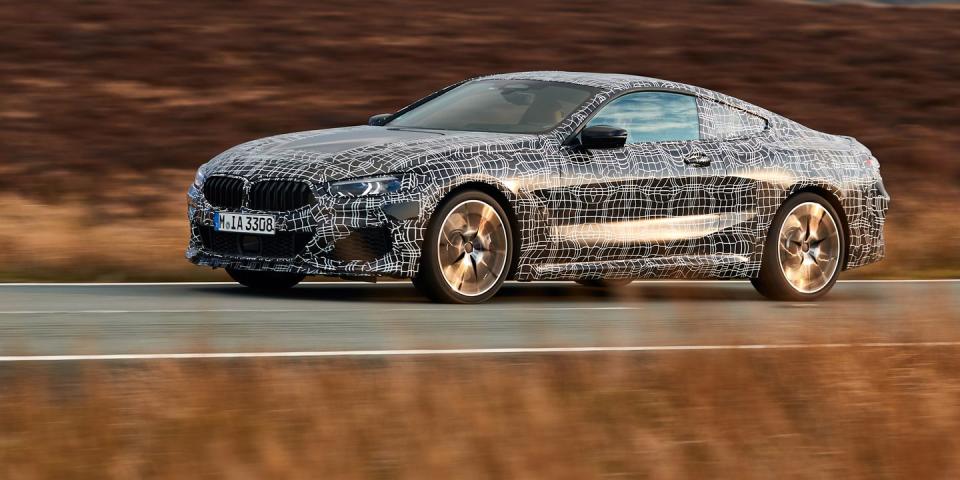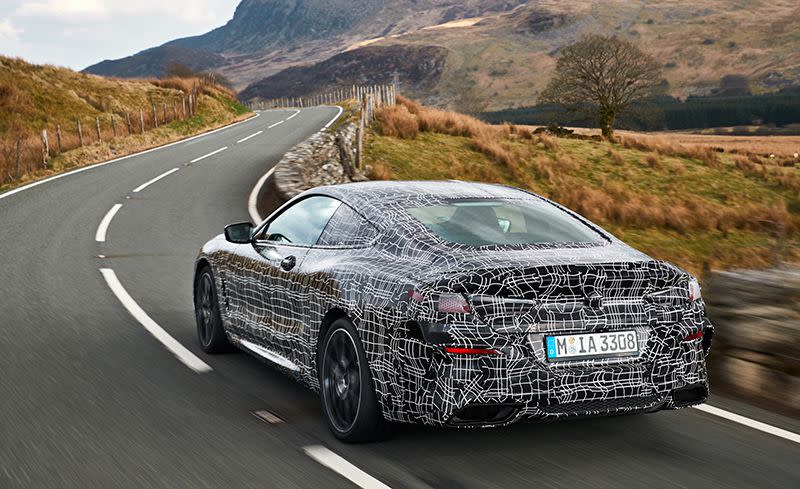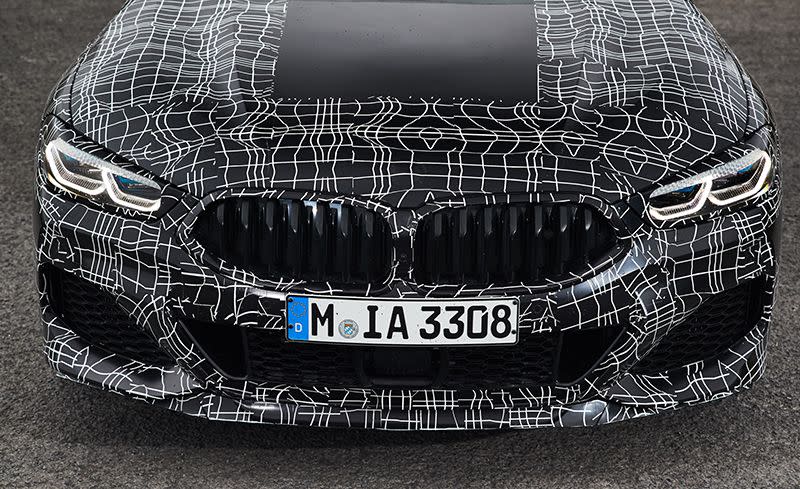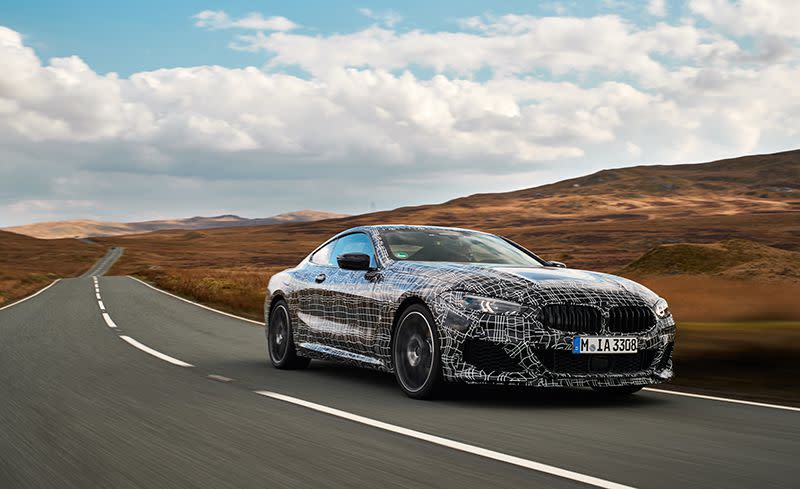We’ve Driven the New BMW 8-series, and the Outlook Is Promising

It’s slightly impolite to introduce BMW’s new 8-series coupe with a look back at the brand’s disappointing behavior over the past decade or so, but it is necessary context for our impression of the prototypes we drove, the new coupe’s achievements, and the shift underway within BMW that it may represent. Bear with us-there’s a happy ending.
Where Has BMW Been?
In a bid to increase sales, BMW about 10 years ago walked away from its characteristic suspension tuning, once the envy of the industry for its ideal balance of athleticism and comfort. Electrically assisted power steering and adaptive dampers were leveraged for an ever-wider tuning envelope whose edges were comfier and sportier, at the request of customers in clinics. Buyers wanted the option to change their cars’ character using selectable driving modes-and to feel the difference.
In went Comfort driving modes that were lazy and soft as well as Sport settings that were overly stiff, with imperfect settings in between. Somewhere in all this discombobulation, BMW lost its legendary steering and chassis feedback based on the dubious premise that customers disliked road feel. Thus, in the eyes of driving enthusiasts, two generations of BMW vehicles were kneecapped.
Where BMW Seems to Be Going
The M850i xDrive, the 8-series M Performance model that replaces today’s non-M 6-series, is a rolling reset of BMW philosophy. (Aside from the M8, the M850i will be the only version of the 8-series coupe we get in the United States; convertible and Gran Coupe 8-series iterations are also planned.) It is set up to be sporty and to deliver better chassis feel than BMWs of late, building on the recently introduced M5’s momentum. After spending a day in camouflaged prototypes on a development drive through Wales, we think BMW is steering back toward the correct existential apex.
Reduced complexity plays a big role. BMW is tuning the M850i’s chassis around a single Bridgestone Potenza S007 summer tire, sized 245/35ZR-20 in front and 275/30ZR-20 at the rear. (Three or four alternative fitments won’t be given nearly as much development attention.) BMW also is making every one of its performance-enhancing active-chassis features standard in our market. This way, it says, the features won’t need to individually stand out in operation, something customers wanted when spending money on such options in previous models. The Dynamic Damper Control (adaptive dampers), Active Roll Stabilization (active anti-roll bars), Integral Active Steering (rear-wheel steering), and electronically controlled locking rear differential all work together to bolster the driver’s sense of control and the M850i’s handling capabilities more so than on any similarly tech-laden BMW we’ve recently driven.
Switching among the Eco Pro, Comfort, Sport, and Sport+ driving modes doesn’t drastically alter the car’s responses to inputs, either. Yes, there are noticeable behavioral differences between the 8’s dullest setting, Eco Pro, and its sportiest, Sport+. What sets the M850i apart is how at both ends of its range reactions to steering and throttle inputs and the resultant body motions feel as if they’re coming from the same car. The consistency traceable through the M850i’s various modes reminds us of the Alfa Romeo Giulia Quadrifoglio’s balance of adjustability with a consistent character.
Simplify the Stuff You Add
Two core suspension settings are shared among the four driving modes. The softer setup is applied in the Eco Pro and Comfort settings, while the firmer is reserved for Sport and Sport+. There isn’t much daylight between the two, which is fine by us-we remember when BMWs used to have a single, perfect setting. The M850i rides firmly although with accommodating initial bump compliance. There is tighter rebound control in Sport and Sport+ but no undue ride harshness, and the tires remain securely in contact with the pavement, even over midcorner disruptions.
BMW’s thinking on active anti-roll measures has evolved, thankfully, beyond eliminating roll altogether and starving drivers of the midcorner feedback that body lean affords. Active Roll Stabilization here allows some lean, and its new target is tweaking chassis balance on the fly. In Sport+, it stiffens the rear-end’s roll resistance, shifting the M850i’s neutral handling attitude toward oversteer. The actuators also “load up” the outside front wheel as you turn into a corner, priming a quicker, more direct-feeling steering response. In concept, the aim is similar to Mazda’s G-Vectoring Control, which uses negative engine torque to imperceptibly shift load to the front wheels and set the tires on turn-in.
Steering Feel, Really!
Happily, the M850i’s electrically assisted steering delivers actual road feel, informing the driver’s hands of the front tires’ grip and sidewall deflections. As befits a luxury sports coupe, the conversation is in an inside voice rather than a shout. Turn-in is quick and satisfying, with a positive feel backed up by stupefying front-end grip.
Better still, Sport and Sport+ don’t needlessly raise the steering effort so high that your shoulders are needed to turn the front wheels. Those settings slightly increase the otherwise lightly weighted steering’s heft and quicken its responses to inputs. The rear-wheel steering variably nudges the rear wheels up to 2.4 degrees in phase with the fronts for improved high-speed stability or out of phase the same amount to whip the tail around in tighter, slower maneuvers. The system never felt unnatural or unpredictable, and we only detected its invisible hand once, under hard trail-braking into a bumpy turn, when it helped to stabilize the car’s bouncing tail.
The M850i’s engine is upgraded relative to the V-8 in the 650i it replaces. It’s a nearly all-new twin-turbocharged 4.4-liter V-8 with larger turbos and an estimated 523 horsepower and 553 lb-ft of torque. As before, the V-8 nestles its turbochargers between the cylinder banks in a “hot vee” configuration, shortening the exhaust gases’ pathways to the turbos and minimizing lag. The engine pulls hard with immediacy at any rpm (peak torque crashes the party at 1800 rpm and refuses to leave after that) and belts out a fantastic bellow through the exhaust’s electronically managed butterfly flaps, which open more readily in Sport and Sport+ modes.
It pairs with a quick-shifting ZF-sourced eight-speed automatic that features a wider ratio spread than the unit in today’s 6-series. The xDrive all-wheel-drive system sends 100 percent of engine torque to the rear axle by default, although traction needs can dictate sending all of that to the front axle or any combination between the two. The powertrain has four truly differentiated settings, but again, the differences between them are subtler than we’re used to from BMW, and Sport+, which returns the quickest throttle response and rev-matched downshifts should you twitch the steering wheel off center or dab the brakes, is bridled enough for street use.
If the production model coming later this year turns out to be as satisfying as these prototypes, consider it a happy ending. The happiest ending, however, would be one where the thinking behind this M850i becomes part of a broader trend at BMW and informs higher-volume products such as the next-generation 3-series.
You Might Also Like

 Yahoo Autos
Yahoo Autos 



